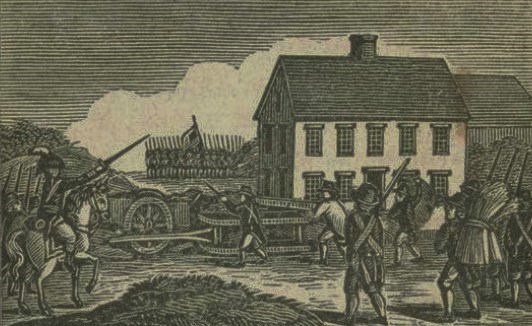Part of a series of articles titled 2023 Preservation Planning Grants Highlights.
Article
Avenging Danbury: Revisiting the Battle of Ridgefield and American attempts to stop the British Raid of 1777

Image courtesy of the Connecticut Historical Society
Recipient: Ridgefield Historical Society
Amount: $117,714.00
As General George Washington’s Continental Army camped in Morristown, New Jersey, in the early part of 1777, they endured the constant threat of smallpox and desertion, while the combined forces of the British military regrouped and maneuvered to cut off American supplies. Looking to counter a series of recent defeats at Trenton and Princeton, New Jersey, the British commander in North America - William Howe - decided to take the war to nearby Connecticut and New York. Howe believed that the destruction of American supply depots located in those the states would give his army a distinct advantage over Washington’s force and compel it to withdraw or disperse.
Using a mixed formation of British Regulars and Crown Loyalists, Howe sent his largest raiding force to destroy the American depot at Danbury, Connecticut in late April of 1777. Reaching the town virtually unopposed, the British burned military stores and equipment, as American Militia gathered from the surrounding towns and prepared a counterattack.
Having completed their objective, the British attempted to withdraw on April 27, but met strong resistance along their line of retreat. Attacked from the rear by Connecticut militiamen, and then harassed throughout the morning, the British Infantry continued to march until they encountered a strong American position outside the town of Ridgefield. Using the local terrain and barricades across the roadway, more American Militia under the command of Brigadier General Benedict Arnold forced the British to deploy into line and fought them for nearly two hours, until their defenses were broken by a concentrated British advance.
Reaching the safety of the British Fleet the next day, Howe’s raiders claimed victory. However, their raid had little effect on the overall war. Writing to the Continental Congress, Washington stated that “the damage we sustained at Danbury was not so great . . . the chief loss [being tents].” For Arnold however, his defense of Ridgefield earned him a promotion to the rank of Major General, and the trust of his troops that would help win the Battle of Saratoga five months later.
A 2023 Preservation Planning Grant from the American Battlefield Protection Program to the Ridgefield Historical Society will allow the non-profit to conduct a second phase of archeological field tests and complete their multi-year effort to map the Revolutionary War battlefield through present day Ridgefield, Connecticut. Using the data points collected from these field tests, the historical society will also develop documentation for a National Register Nomination.
Preservation Planning Grants are the American Battlefield Protection Program's broadest and most inclusive grant program, promoting the stewardship of battlefields and sites of armed conflict on American soil. In addition, ABPP administers three other grant opportunities: the Battlefield Land Acquisition Grant, Battlefield Restoration Grant, and Battlefield Interpretation Grant programs. This financial assistance generates community-driven stewardship of historic resources at the state, tribal and local levels.
Get Your Project Funded
Check out the American Battlefield Protection Program's website for more information about various grant offerings and eligibility.Check out the American Battlefield Protection Program's website for more information about various grant offerings and eligibility.
Last updated: July 26, 2023
